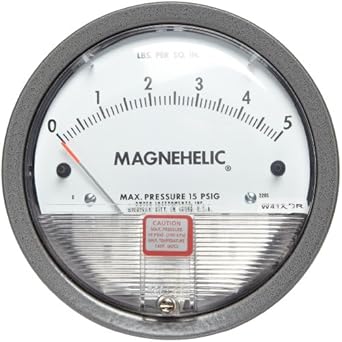The Magnehelic pressure gauge is an essential tool in various industrial and laboratory settings, primarily used for measuring differential pressure. Its ability to provide accurate readings has made it a staple in industries ranging from HVAC (Heating, Ventilation, and Air Conditioning) to cleanroom environments. This article will explore the Magnehelic gauge’s principles, applications, advantages, and maintenance tips, providing a thorough understanding of this vital instrument.
What is a Magnehelic Pressure Gauge?

The Magnehelic gauge is a type of differential pressure gauge that utilizes a unique design based on a diaphragm and magnetic sensing technology. It offers a direct reading of pressure differences in various systems, allowing users to monitor conditions effectively. Unlike traditional gauges, the Magnehelic gauge is known for its simplicity, accuracy, and ease of use.
How Does the Magnehelic Gauge Work?

The operation of a Magnehelic gauge is founded on the principles of fluid dynamics and magnetism. Here’s a step-by-step breakdown of its working mechanism:
- Diaphragm Movement: The gauge features a flexible diaphragm that responds to pressure differences between two ports. When pressure is applied, the diaphragm bends, causing movement.
- Magnetic Coupling: Attached to the diaphragm is a magnet that moves in conjunction with the diaphragm’s deflection. This magnet is positioned within a magnetic field created by a coil.
- Pointer Movement: As the magnet moves, it drives a pointer across a calibrated dial, providing a visual representation of the pressure differential.
This design allows for high sensitivity and accuracy, making Magnehelic gauges suitable for low-pressure measurements in various applications.
Applications of the Magnehelic Gauge

The versatility of the Magnehelic gauge extends across numerous industries. Here are some common applications:
- HVAC Systems: Used to monitor filter conditions and airflow in ventilation systems.
- Cleanrooms: Measures pressure differentials to ensure contamination control and maintain sterile environments.
- Laboratories: Monitors pressure in fume hoods and other laboratory equipment to ensure safety.
- Industrial Processes: Used in various manufacturing processes to maintain optimal operating conditions.
Advantages of Using a Magnehelic Gauge
There are several key benefits to utilizing a Magnehelic pressure gauge in both industrial and laboratory settings:
- Accuracy: The gauge provides precise readings, ensuring reliable pressure measurements.
- Ease of Use: With a simple dial readout, it is user-friendly and requires minimal training to operate.
- Durability: Designed to withstand harsh environments, Magnehelic gauges are built for longevity.
- Low Maintenance: These gauges require minimal maintenance, making them cost-effective over time.
Limitations of the Magnehelic Gauge

While Magnehelic gauges offer numerous advantages, they also come with limitations that users should consider:
- Range Limitations: They are best suited for low-pressure applications and may not provide accurate readings for high-pressure situations.
- Calibration Needs: Regular calibration is necessary to maintain accuracy, which can require additional time and resources.
- Environmental Sensitivity: Extreme temperatures or humidity levels may affect performance and accuracy.
How to Select the Right Magnehelic Gauge

Choosing the right Magnehelic gauge for your specific needs requires careful consideration of several factors:
- Pressure Range: Determine the maximum and minimum pressure differentials you need to measure.
- Accuracy Requirements: Consider the level of precision required for your application.
- Mounting Options: Ensure the gauge can be easily installed in your existing system.
- Calibration Standards: Check if the gauge meets the necessary calibration standards for your industry.
Case Study: Magnehelic Gauges in HVAC Systems

To illustrate the practical applications of Magnehelic gauges, consider a case study involving a commercial HVAC installation. In this scenario, a building management team was facing challenges with maintaining optimal airflow levels across multiple zones. By integrating Magnehelic gauges, they were able to:
- Monitor differential pressure across air filters to determine when replacements were needed, leading to improved air quality.
- Optimize fan speed based on real-time pressure data, reducing energy costs by 15%.
- Enhance occupant comfort through consistent temperature and humidity levels, resulting in increased tenant satisfaction.
This case highlights the potential of Magnehelic gauges to improve operational efficiency and reduce costs in HVAC systems.
Maintaining Your Magnehelic Gauge
Proper maintenance is crucial for ensuring the longevity and accuracy of your Magnehelic gauge. Here are some maintenance tips:
- Regular Calibration: Schedule periodic calibration to ensure accuracy and compliance with industry standards.
- Visual Inspections: Regularly check for any physical damage or wear and tear.
- Cleanliness: Keep the gauge and its connections clean to prevent blockages and ensure accurate readings.
- Proper Storage: When not in use, store the gauge in a controlled environment to protect it from extreme conditions.
The Magnehelic pressure gauge is an invaluable instrument for accurately measuring differential pressure across a variety of applications. Its unique design, coupled with its ease of use and low maintenance requirements, makes it an ideal choice for industries including HVAC, cleanrooms, and laboratories. While there are limitations to consider, the advantages often outweigh the drawbacks, especially when used in the right applications.
By understanding the working principles of the Magnehelic gauge, its applications, and how to maintain it properly, users can maximize the benefits of this essential tool. Whether you are optimizing an HVAC system or ensuring safety in a laboratory, the Magnehelic gauge stands out as a reliable and efficient solution for pressure measurement needs.


